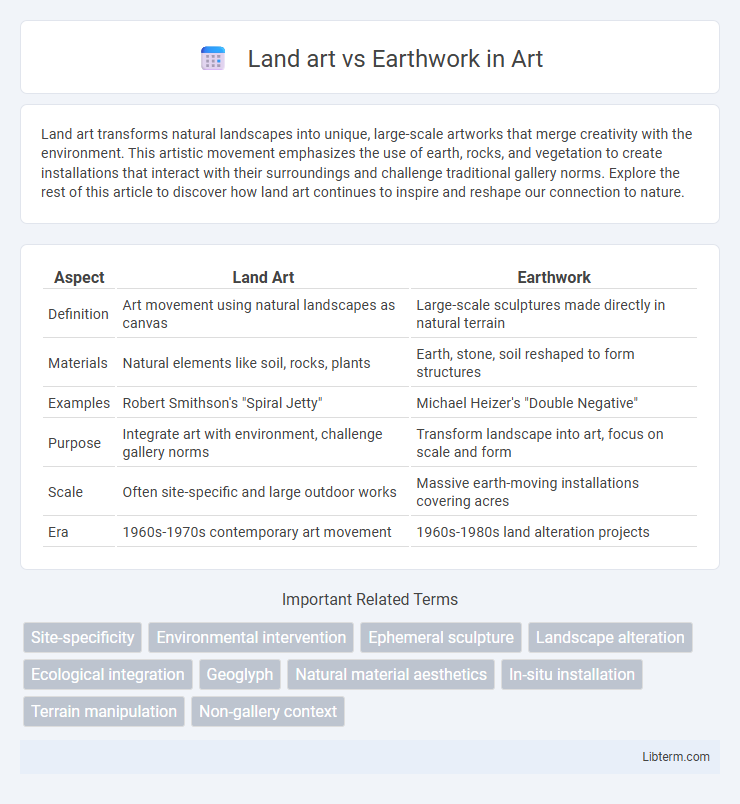Land art transforms natural landscapes into unique, large-scale artworks that merge creativity with the environment. This artistic movement emphasizes the use of earth, rocks, and vegetation to create installations that interact with their surroundings and challenge traditional gallery norms. Explore the rest of this article to discover how land art continues to inspire and reshape our connection to nature.
Table of Comparison
| Aspect | Land Art | Earthwork |
|---|---|---|
| Definition | Art movement using natural landscapes as canvas | Large-scale sculptures made directly in natural terrain |
| Materials | Natural elements like soil, rocks, plants | Earth, stone, soil reshaped to form structures |
| Examples | Robert Smithson's "Spiral Jetty" | Michael Heizer's "Double Negative" |
| Purpose | Integrate art with environment, challenge gallery norms | Transform landscape into art, focus on scale and form |
| Scale | Often site-specific and large outdoor works | Massive earth-moving installations covering acres |
| Era | 1960s-1970s contemporary art movement | 1960s-1980s land alteration projects |
Introduction to Land Art and Earthwork
Land Art and Earthwork are artistic movements that integrate natural landscapes into their creations, often using soil, rocks, and vegetation as primary materials. Land Art, emerging in the late 1960s, emphasizes large-scale outdoor installations that alter the environment to create lasting art pieces. Earthwork specifically refers to the process and result of physically shaping the earth, exemplified by works like Robert Smithson's "Spiral Jetty," highlighting the interaction between art, nature, and geography.
Historical Origins of Land Art
Land art originated in the late 1960s as a movement where artists created site-specific works directly within natural landscapes, often using materials like soil, rocks, and vegetation. This artistic practice emerged as a response to traditional gallery spaces, emphasizing environmental interaction and the impermanence of art. Earthworks, a subset of Land art, specifically involve large-scale sculptural modifications to the earth, exemplified by iconic projects such as Robert Smithson's "Spiral Jetty" created in 1970.
Defining Key Characteristics of Earthworks
Earthworks are large-scale sculptural interventions that manipulate the natural landscape through techniques such as excavation, mounding, or carving, often emphasizing site-specificity and environmental interaction. Unlike general Land art, which includes diverse materials and smaller installations, Earthworks prioritize altering earth materials to create enduring, monumental forms visible from multiple perspectives. Key characteristics of Earthworks include their monumental scale, integration with natural topography, and use of native earth materials to engage ecological processes and natural cycles.
Influential Artists in Land Art Movement
Robert Smithson, known for his seminal work "Spiral Jetty," is a pivotal figure in the Land Art movement, utilizing natural landscapes to challenge traditional art forms. Nancy Holt, another key artist, integrated environmental elements and time-based components in installations like "Sun Tunnels," emphasizing cosmic alignments and natural phenomena. Michael Heizer's monumental earthworks, including "Double Negative," highlight the interplay between human intervention and the vastness of untouched landscapes, solidifying his influence within the Earthwork subset of Land Art.
Iconic Examples of Earthwork Installations
Iconic examples of earthwork installations include Robert Smithson's "Spiral Jetty," a monumental coil of rock and earth extending into Utah's Great Salt Lake, which exemplifies the integration of art with natural landscapes. Walter De Maria's "The Lightning Field" in New Mexico features 400 stainless steel poles spread across a vast desert, creating a dynamic interaction with weather and light. Michael Heizer's "Double Negative" consists of two massive trenches cut into the desert floor in Nevada, emphasizing the earth's raw materials and spatial voids in land art.
Artistic Intentions: Land Art vs Earthwork
Land Art emphasizes transforming natural landscapes to create site-specific works that challenge traditional gallery settings and highlight environmental context. Earthwork focuses more on manipulating earth materials to explore ecological processes and the relationship between humans and nature. Both prioritize interaction with the environment, but Land Art often carries a conceptual critique of art institutions, while Earthwork underscores ecological awareness and sustainability.
Environmental Impact and Sustainability
Land art and earthwork both engage directly with natural landscapes, but their environmental impacts and sustainability differ significantly. Land art typically integrates minimal alteration of the environment, emphasizing harmony with ecosystems and using natural materials that degrade harmlessly over time. Earthwork often involves substantial modification of the terrain, which can risk habitat disruption and soil erosion, yet sustainable earthworks employ regenerative techniques to restore land and promote ecological balance.
Audience Interaction and Accessibility
Land art often emphasizes audience interaction through immersive, large-scale outdoor installations that invite physical exploration and sensory engagement, fostering a direct connection with natural environments. Earthwork, while similarly site-specific, tends to highlight environmental transformation and geological processes, sometimes limiting accessibility due to remote locations or fragile ecosystems. Both forms challenge traditional gallery experiences but vary in how readily audiences can access and interact with the artworks, influencing public engagement and educational opportunities.
Preservation and Ephemeral Nature
Land art often emphasizes the ephemeral nature of artworks, intentionally allowing natural processes like erosion and weathering to reshape or erase the piece over time, highlighting the passage of time and environmental interaction. Earthworks typically involve large-scale interventions that embed the artwork into the landscape, raising complex challenges for preservation due to their susceptibility to natural decay and human impact. Conservation efforts for both forms prioritize minimal interference, focusing on documenting the work through photography and digital media to preserve its essence while accepting its transient existence.
Contemporary Interpretations and Future Trends
Contemporary interpretations of Land art and Earthwork emphasize ecological sustainability and community engagement, blending natural materials with digital technology to create dynamic, interactive installations. Artists increasingly incorporate climate change themes and indigenous perspectives, driving environmental awareness through immersive experiences rooted in specific landscapes. Future trends suggest a growing integration of augmented reality and renewable energy, expanding the spatial and sensory dimensions of Land art and Earthwork while fostering global connectivity.
Land art Infographic

 libterm.com
libterm.com